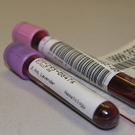Articles tagged with: Free Light Chains
News»

Light chain monoclonal gammopathy of undetermined significance (MGUS) has a very low probability of progressing to symptomatic multiple myeloma, according to the results of a new study by researchers in Germany.
The German researchers found that, with a median follow-up time of 11.5 years, none of the 75 people in their study who had light chain MGUS saw their MGUS progress to symptomatic multiple myeloma, amyloidosis, or a related disease.
In fact, in more than half of the 31 cases where the necessary laboratory results were available, study participants who initially met …
News»

How has your week started, myeloma world?
We hope it's going well so far.
We once again have a rather long list of new myeloma research we'd like to discuss with you. We suspect most of our readers will find at least one or two studies in the report to be of particular interest.
We begin today's report with a discussion of a somewhat rare eye-related side effect of Velcade (bortezomib) and a possible way to control the side effect.
Next, we take a quick look at two articles about …
News»

Results of a recent retrospective analysis show that the heavy/light chain test has high potential as a tool for the detection of abnormal monoclonal protein, the evaluation of response to therapy, and as a prognostic marker in multiple myeloma patients.
The heavy/light chain test was more sensitive to low levels of monoclonal (M)-protein compared to conventional detection methods. Thus, the study investigators conclude that the test may become valuable in confirming and quantifying M-protein levels, measuring patient responses to treatment, detecting early signs of relapse, and identifying residual disease in multiple myeloma …
News»

A type of test called the free light chain assay can frequently detect oligosecretory disease in multiple myeloma patients. The findings, discussed in a letter to the editor of The New England Journal of Medicine, also indicate that oligosecretory myeloma is more prevalent at later stages of the disease.
Oligosecretory myeloma, along with nonsecretory myeloma, is a subset of multiple myeloma. Nonsecretory myeloma patients have no measureable levels of monoclonal (M) protein in their urine or blood. Similarly, oligosecretory myeloma patients have very low M-protein levels, also known as the M-spike, in …
News»

The results of a small Spanish study indicate that heavy/light chain ratios may be a prognostic marker for myeloma patients.
Specifically, the Spanish researchers found that multiple myeloma patients who experienced elevated heavy/light chain ratios after achieving complete remission following a stem cell transplant had longer progression-free and overall survival rates than patients who did not experience elevated heavy/light chain ratios.
According to the study investigators, these results show for the first time the association between a heavy/light chain ratio and sustained remission in myeloma patients.
However, larger follow-up studies may be …
News»

Results of a small Australian study show that patients with the myeloma precursor diseases monoclonal gammopathy of undetermined significance and smoldering multiple myeloma experienced reduced levels of free light chains while taking curcumin.
Free light chains are proteins in the blood that are known to be linked to myeloma cell activity.
The Australian researchers also found that patients had reduced levels of bone breakdown while taking curcumin.
“A number of the patients in this study did show a free light chain response, and we suspect that curcumin should be incorporated …

